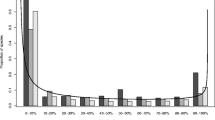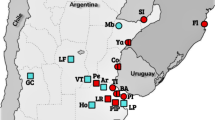Abstract
Wolbachia are Gram-negative bacteria that cause intracellular inherited infections in many invertebrates. They are extremely common, with 20–75 % of all insects being infected. Wolbachia belong to taxa of the Anaplasmataceae family, alpha proteobacteria. Because previous studies have shown that Wolbachia generally disappear from the host insect’s body under high-temperature conditions in laboratories, we investigated seasonal changes in infection of the pale grass blue butterfly, Zizeeria maha (Kollar, 1848) by Wolbachia, for 7 months of the year. Total annual infection was 86.7 % (n = 15) of females and 96.3 % (n = 81) of males. Statistical analysis showed that monthly infection was not significantly different among months. In addition, no significant difference was found between Wolbachia densities in cells of summer and winter butterfly samples by use of real-time PCR during the months examined. The results suggest that Wolbachia infection is not affected by seasonal factors, at least for Z. maha.


Similar content being viewed by others
References
Bandi C, Anderson TJC, Genchi C, Blaxter ML (1998) Phylogeny of Wolbachia in filarial nematodes. Proc Roy Soc Lond B 265:2407–2413
Bouchon D, Rigaud T, Juchault P (1998) Evidence for widespread Wolbachia infection in isopod crustaceans: molecular identification and host feminization. Proc Roy Soc Lond B 265:1081–1090
Braig HR, Zhou W, Dobson SL, O’Neill SL (1998) Cloning and characterization of a gene encoding the major surface protein of the bacterial endosymbiont Wolbachia pipientis. J Bacteriol 180:2373–2378
Breeuwer JAJ, Jacobs G (1996) Wolbachia: intracellular manipulators of mite reproduction. Exp Appl Acarol 20:421–434
Charlat S, Engelstädter J, Dyson EA, Hornett EA, Duplouy A, Tortosa P, Davies N, Roderick GK, Wedell N, Hurst GDD (2006) Competing selfish genetic elements in the butterfly Hypolimnas bolina. Curr Biol 16:2453–2458
Engelstädter J, Telschow A (2009) Cytoplasmic incompatibility and host population structure. Heredity 103:196–207
Folmer O, Black M, Hoeh W, Lutz R, Vrijenhoek R (1994) DNA primers for amplification of mitochondrial cytochrome c oxidase subunit I from diverse metazoan invertebrates. Mol Mar Biol Biotech 3:294–299
Guruprasad NM, Mouton L, Puttaraju HP (2011) Effect of Wolbachia infection and temperature variations on the fecundity of the Uzifly Exorista sorbillans (Diptera: Tachinidae). Symbiosis 54:151–158
Hilgenboecker K, Hammerstein P, Schlattmann P, Telschow A, Werren JH (2008) How many species are infected with Wolbachia?—a statistical analysis of current data. FEMS Microbiol Lett 281:215–220
Hurst GDD, Jiggins FM, Robinson SJW (2001) What causes inefficient transmission of male-killing Wolbachia in Drosophila? Heredity 87:220–226
Institute SAS (2007) JMP user’s manual version, 7th edn. SAS Institute, Cary
Jeyaprakash A, Hoy MA (2000) Long PCR improves Wolbachia DNA amplification: wsp sequences found in 76 % of sixty-three arthropod species. Insect Mol Biol 9:393–405
Johanowicz DL, Hoy MA (1998) Experimental induction and termination of non-reciprocal reproductive incompatibilities in a parahaploid mite. Entomol Exp Appl 87:51–58
Lehmann T, Dao A, Yaro AS, Adamou A, Kassogue Y, Diallo M, Sékou T, Coscaron-Arias C (2010) Aestivation of the African Malaria Mosquito, Anopheles gambiae in the Sahel. Am J Trop Med Hyg 83:601–606
Mouton L, Henri H, Bouletreau M, Vavre F (2006) Effect of temperature on Wolbachia density and impact on cytoplasmic incompatibility. Parasitology 132:49–56
O’Neill SL, Hoffmann AA, Werren JH (1997) Influential passengers: inherited microorganisms and arthropod reproduction. Oxford University Press, Oxford
Perrot-Minnot MJ, Guo LR, Werren JH (1996) Single and double infections with Wolbachia in the parasitic wasp Nasonia vitripennis: effects on compatibility. Genetics 143:961–972
Stouthamer R, Luck RF, Hamilton WD (1990) Antibiotics cause parthenogenetic Trichogramma (Hymenoptera, Trichogrammatidae) to revert to sex. P Natl Acad Sci USA 87:2424–2427
Stouthamer R, Breeuwer JAJ, Hurst GDD (1999) WOLBACHIA PIPIENTIS: microbial manipulator of arthropod reproduction. Annu Rev Microbiol 53:71–102
Tagami Y, Miura K (2004) Distribution and prevalence of Wolbachia in Japanese populations of Lepidoptera. Insect Mol Biol 13:359–364
Van Opijnen T, Breeuwer JAJ (1999) High Temperatures Eliminate Wolbachia, a cytoplasmic incompatibility inducing endosymbiont, from the two-spotted spider mite. Exp Appl Acarol 23:871–881
Werren JH (1997) Biology of Wolbachia. Annu Rev Entomol 42:587–609
Werren JH, Windsor DM (2000) Wolbachia infection frequencies in insects: evidence of a global equilibrium? Proc R Soc Lond B 267:1277–1285
Werren JH, Windsor D, Guo L (1995) Distribution of Wolbachia among neotropical arthropods. Proc R Soc Lond B 262:197–204
Werren JH, Baldo L, Clark ME (2008) Wolbachia: master manipulators of invertebrate biology. Nat Rev Microbiol 6:741–751
Acknowledgments
This study was partially supported by Kakenhi 23570027 Grant-in-Aid for Scientific Research, JSPS and MEXT to T.M.
Author information
Authors and Affiliations
Corresponding author
Rights and permissions
About this article
Cite this article
Sumi, T., Miura, K. & Miyatake, T. No seasonal trend in infection of the pale grass blue butterfly, Zizeeria maha (Lepidoptera: Lycaenidae), by Wolbachia . Appl Entomol Zool 48, 35–38 (2013). https://doi.org/10.1007/s13355-012-0152-4
Received:
Accepted:
Published:
Issue Date:
DOI: https://doi.org/10.1007/s13355-012-0152-4




